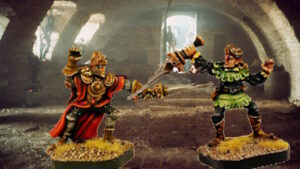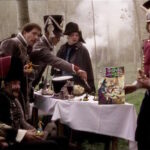 Alternative Armies’ En Garde includes not just one set of dueling rules, but three.
Alternative Armies’ En Garde includes not just one set of dueling rules, but three.
Unlike the swordplay duel, which include everything from strength to reflexes to movement to endurance, the rules for the pistol duel are simple and streamlined. The duel itself is comprised of four phases, the first three of which are a test of nerve and the last of which resolves the actual shots:
- The challenge
- The walk
- The turn
- The shot
Every duelist gets one each of the five die types used in the game, and in each phase will select a die to use for its action. A roll of 5+ indicates a success and a 10+ indicates a critical success which will lead to bonuses in one or more of the following phases. In the case of the first three steps, the roll is made to determine whether or not the figure holds its nerve. If the die roll is four or less not only will the figure suffer a penalty in the fourth and deadliest phase, but that die type won’t be available for the actual firing of your pistol.
 In the last phase, both players secretly select on of their remaining dice to use for the shot. As with swordplay, lower die types activate first, providing a chance to dispatch your foe before he can fire his own pistol. The catch is that lower die types also mean a lower chance of successfully hitting your foe. You have to choose between speed and accuracy. It’s worth noting that to beat your opponent to the draw you need to act two die types lower, otherwise both duellists will get a chance to fire. In other words, if you select a d8 for your shot, then you will still suffer a responding shot if your opponent uses a d10 for his own. And of course, if you miss or merely graze your opponent you’ll have to stand there like a dope and take the shot regardless of how high a die type he selected. The same can be said if you wound your opponent, but a wounded opponent faces a penalty to his attacks, which is of some reassurance.
In the last phase, both players secretly select on of their remaining dice to use for the shot. As with swordplay, lower die types activate first, providing a chance to dispatch your foe before he can fire his own pistol. The catch is that lower die types also mean a lower chance of successfully hitting your foe. You have to choose between speed and accuracy. It’s worth noting that to beat your opponent to the draw you need to act two die types lower, otherwise both duellists will get a chance to fire. In other words, if you select a d8 for your shot, then you will still suffer a responding shot if your opponent uses a d10 for his own. And of course, if you miss or merely graze your opponent you’ll have to stand there like a dope and take the shot regardless of how high a die type he selected. The same can be said if you wound your opponent, but a wounded opponent faces a penalty to his attacks, which is of some reassurance.
But go back to the first three steps again. If you lose your nerve during any of those steps, not only is your shot with a negative modifier to the die roll, you lose that die type. And your opponent knows that. That means when it comes time for the guesswork inherent in the final round, your opponent will have a better chance of predicting your strategy. The winner is the one who suffers the least amount of damage, although in the event both shots miss they will be reloaded and the process repeats with a fresh pool of dice.
As with the swordplay duels, one’s behavior in a duel will earn him honor points and boost (or harm) his reputation. Scoring a 10+ on the challenge, for example, scores an extra honor point due to the grace and elegance with which your figure issued or accepted the challenge. You can also spend honor points that you have saved up to do things like recover a lost die type, which doesn’t affect your reputation score.
One might object to how little influence a character’s stat line has on the process, but this is perfectly in keeping with the nature of pistol duels. Your physical stats matter far less than your nerve. The reliability of the pistols matters far more than your aim. And the rules reflect this perfectly.
The rules of En Garde present the possibility of a dueling tournament in which each figure duels every other figure once, with the winner being the survivor that wins the most duels. You can keep track of honor and reputation as the tournament progresses, which would allow for the runners-up to still come out ahead from experience points if not gold medals. To conduct a tournament more efficeintly, the players could dice to determine whether the duel fought via swordplay (expect about 20 minutes each) or pistols (which take about 5 minutes). With a 50-50 shot at each, you could run an eight player tournament in an afternoon.

